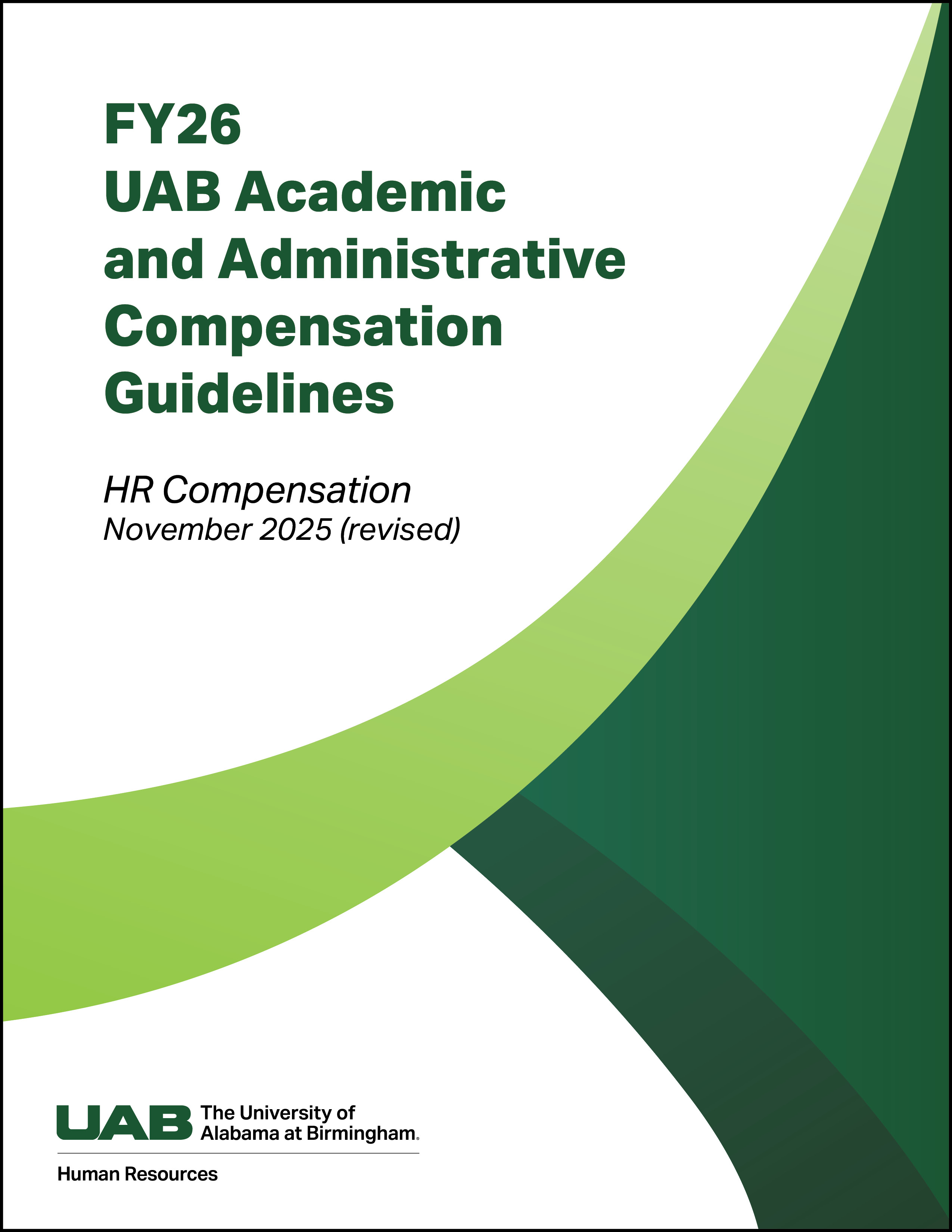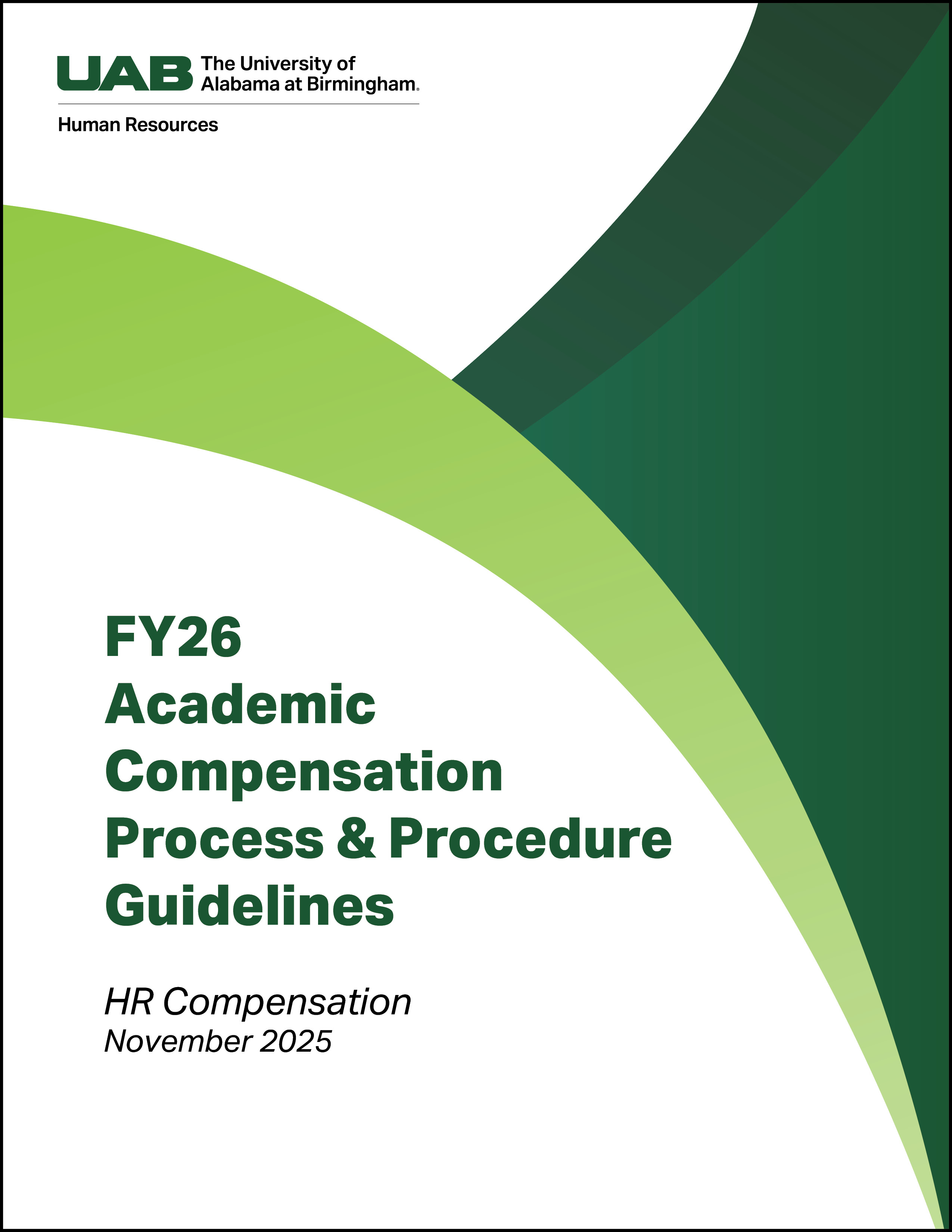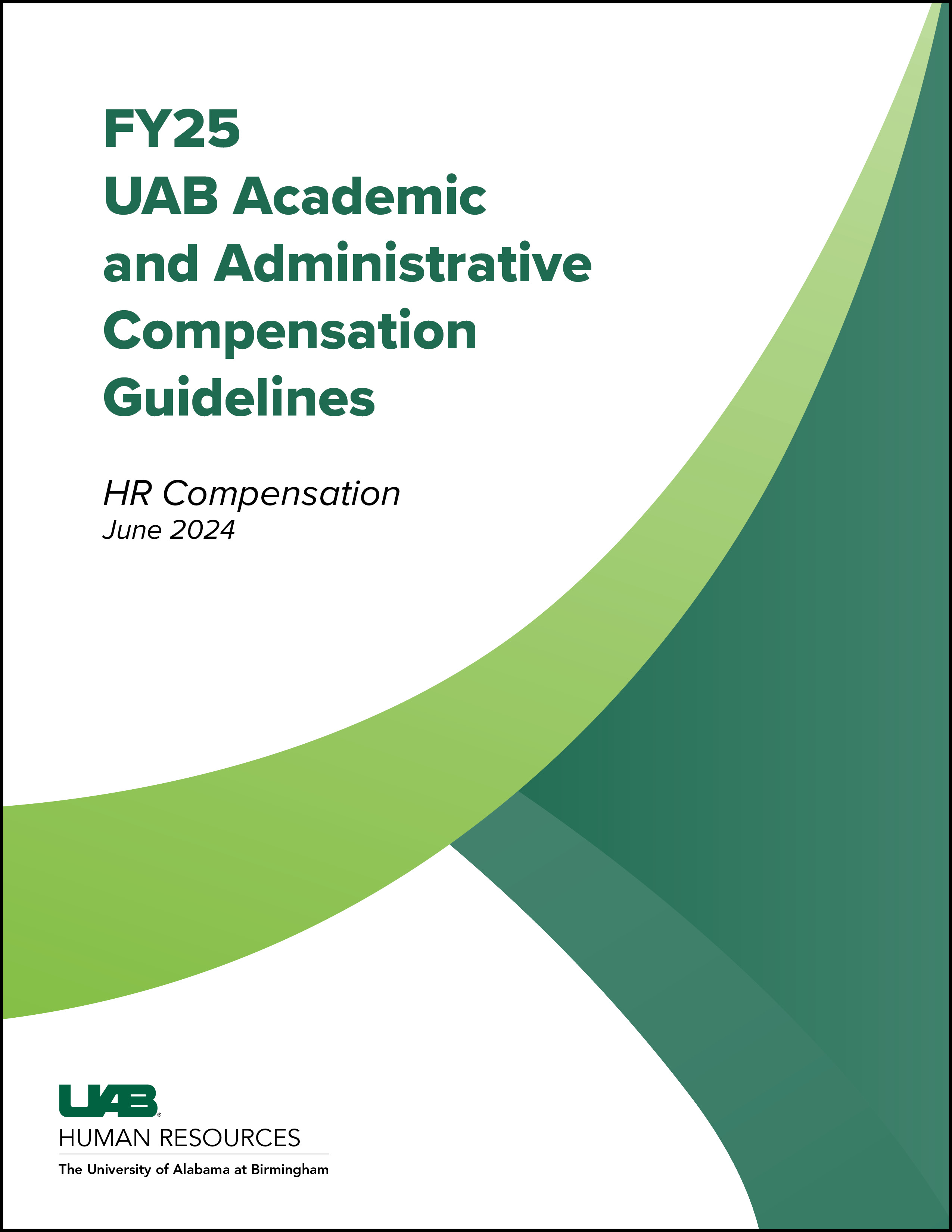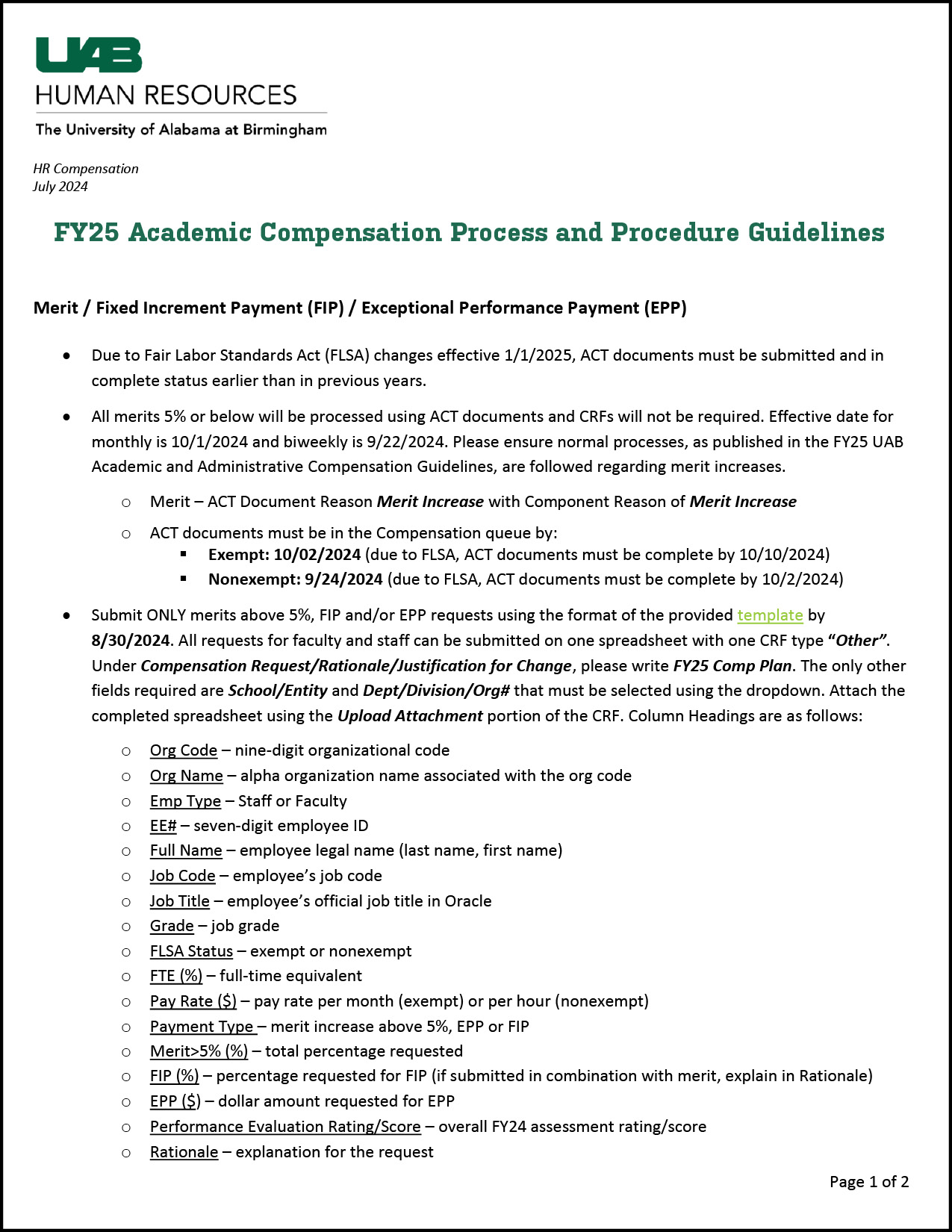As Organizational Leaders continue to assess how to best invest limited institutional resources, it is imperative that the University implement and promote faculty and staff compensation practices that effectively support our most important asset — our people. To assist our academic and administrative units with these decisions, the following Compensation Guidelines are provided for UAB Medicine and UAB academic/administrative units.
Compensation forms and templates previously located in this section can now be found in the Compensation Forms section in the Compensation Toolkit.
-
Fiscal Year 2026
Click on an image below to download/print FY26 documents.

FY26 UAB Academic & Administrative Compensation Guidelines
(updated 11/21/2025)

FY26 Academic Compensation Process & Procedure Guidelines
(posted 11/20/2025)
-
Fiscal Year 2025
Click on image below to download/print FY25 document.

FY25 UAB Academic & Administrative Compensation Guidelines
(updated 6/28/2024)

FY25 Academic Compensation Process and Procedure Guidelines
(posted 7/11/2024)
-
Job Roles
A large, complex organization such as UAB needs an efficient and effective communication channel that delivers timely information to those that need the information. Job roles help create focused communication channels for delivering information related to learning & development services, policy updates, cascading of organizational initiatives and more.
Click here to review job role criteria or download the UAB Job Roles Guide (PDF) for more information.

-
Merit Matrix Guidelines
A Merit Matrix is a table created to help managers equitably allocate their merit pool dollars across their employee population. A merit matrix provides broad range merit increase bands that are based on the merit budget and employee job performance. It is a guide to help managers distribute the department’s merit pool equitably based on individual performance.
Merit Matrix Example(based on a 3% Merit Budget Pool)
Overall Rank/Score Rank Definition Merit Increase Range 1 Does Not Meet Expectations 0 2 Meets Some But Not All Expectations 0 3 Meets Expectations 1.0-2.5% 4 Meets All, Exceeds Some Expectations 2.6-3.5% 5 Consistently Exceeds Expectations 3.6-5% NOTE: Merit increases begin at an overall performance evaluation score of 3 or higher.
-
Guidelines for the Use of Working Titles
The UAB compensation and classification structure provides classification titles that are descriptive of the work performed, consistent within assigned job families, and titled within the character limitations of the HRIS operating system. However, when a more specific title would serve the unit’s operational interest, a working title or functional title may be used to describe the function of the position in even greater detail or in more easily recognized terms in both internal and external communications.
The Philosophy of Working Titles- Titles will match the position description scope and responsibilities and reflect the job family to which the position has been assigned.
- Title usage should be consistent throughout the institution.
- Titles should be consistent with those in a similar setting or field such as higher education or the healthcare industry.
- Titles should be appropriately ranked within the hierarchical job role standards.
Acceptable Use of Working TitlesWorking titles may be used in lieu of the University classification title for the following:
- Recruitment searches and job postings to meet job market titling trends or to better describe the job role and scope.
- Departmental specific job descriptions or job description addendums held within the department.
- For business correspondence, both internal and external to the University to clarify the job role and job scope.
Working Titles Should Not...- Duplicate a title used in another employee group for an already established job role.
- Misrepresent the University or the authority of the position in any way. The use of a working title cannot create inflated or inaccurate expectations of the individual’s job role, job scope or authority.
- Use any title that is recognized as an institutional officer such as President, Vice President, Dean, Chief, Provost or other titled positions that are generally recognized as institutional officers.
Determining the Need for a Working TitleIn determining the need for a working title, the supervisor and the employee should consider the following:
- Does the University job classification title adequately describe the function of the job assignment for professional business communications inside and/or outside the University?
- Are there other terms that would clarify and more accurately describe the function of the job assignment?
- Would a working title provide a more accurate and recognizable understanding of the relationship between jobs and/or function within a work unit or organization?
- Does the proposed working title follow the philosophy and acceptable use of guidelines established in this document?
Supervisors should discuss their interest in a working title with their departmental leadership and unit Human Resources Representative. When an appropriate working title has been identified, the unit Human Resources Representative will initiate discussion with Senior Human Resources Leadership if deemed necessary. Consideration in working title reviews will include the guidelines established in this document as well as any additional organizational guidelines that may be established within a specific college or division, the consistency of titles within units or professions, and/or other relevant factors when approving requests for working titles. Senior Human Resources Leadership may also change or withdraw approval of a working title with notice provided to the individual(s) impacted. -
Compensation Guidelines Archives
- FY26 UAB Academic/Administrative Guidelines (pre-merit revision)
- FY25 UAB Academic/Administrative Guidelines
- FY25 Academic Compensation Process & Procedure
- FY24 UAB Academic/Administrative Guidelines
- FY24 Academic Compensation Process & Procedure
- FY23 UAB Academic/Administrative Guidelines
- FY23 Academic Compensation Process & Procedure
- FY22 UAB Academic/Administrative Guidelines
- FY22 Academic Compensation Process & Procedure
- FY21 UAB Academic/Administrative Guidelines
- FY20 UAB Medicine Guidelines
- FY20 UAB Academic/Administrative Guidelines
- FY19 UAB Medicine Guidelines
- FY19 UAB Academic/Administrative Guidelines
- FY18 UAB Medicine Guidelines
- FY18 UAB Academic/Administrative Guidelines
- FY17 UAB Medicine Guidelines
- FY17 UAB Academic/Administrative Guidelines
- FY16 UAB Medicine Guidelines
- FY16 UAB Academic/Administrative Guidelines
- FY15 UAB Medicine Guidelines
- FY15 UAB Academic/Administrative Guidelines
- FY14 Academic/Administrative Guidelines
- FY13 Academic/Administrative Guidelines
- FY12 Academic/Administrative Guidelines